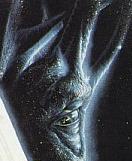
Residence: Seven Heavens (Road of Good Intentions 666)
Description: Paladine is Father of Good and Master of Law. He speaks for the gods of Good, leading them not by restriction but by example and encouragement. Paladine upholds the laws of Good, assisting the righteous and abjuring the evil.
During the Age of Dreams, Paladine led the gods in creation. Before aught else was made, Paladine and Takhisis infused the raw fury of chaos with form and purpose. Thus they created the first material things - dragons. Takhisis, jealous that the first creatures were not entirely hers, corrupted the chromatic dragons to make them Evil. Paladine replaced his fallen children with the Good, metallic dragons, but Takhisis's corrupting act began the rift between Good and Evil.
Takhisis then sought to dominate the newly-created star-spirits. Thus the rift widened into a canyon. Paladine in righteous anger, launched the All-Saints War against the Evil gods. The war ended with both sides wounded, but the battlefield, Krynn, was nearly destroyed. Paladine, saddened by the devastation, swore never again to make war on the world.
And so, Paladine learned subtlety in his conflict with the Evil gods. By working through worshippers rather than in person, Paladine could bring about slow change without jeopardizing the fragile stuff of creation. Paladine counseled the other gods of Good to do likewise, and they have.
In one of history's darkest hours, though, when Takhisis loomed over dthe world like an inescapable plague, Paladine realized he needed a more powerful weapon in the fight for Good. Joining with his sons Kiri-Jolith - god of war, glory, honor and duty - and Habbakuk - god of harmony and nature - Paladine created the Knights of Solamnia. They chose the human hero of liberty, Vinas Solamnus to establish the knighthood, basing it on the ideals of truth, justice, and honour. The Solamnic Knights proved weapon enough to thwart Evil's plots for a millennium. Then in the throes of the third Dragon War, Paladine honed the edge of this weapon by revealing the secret of the Dragonlance.
Many legends suggest that Huma, hero of the Dragonlance who exacted an oath from the Queen of Darkness herself, was Paladine's avatar. This is false. Huma was indeed a mortal, acting with divine guidance perhaps, but still a mortal. Because this mere man's history-shattering sacrifice is difficult to accept, many prefer to consider him divine rather than aspire to his golden example.
Today, Paladine is honoured by all orders of the Solamnic Knights. He is patron of the Order of the Rose.
Paladine's constellation guards Gilean's constellation (the Book of Knowledge). According to tradition, Paladine's constellation occupies this position because truth and knowledge are essential weapons in combatting Evil. During the War of the Lance, the constellations of Paladine and Takhisis both vanished from the heavens, a warning to the people of Krynn. Once the Dark Queen was defeated and banished, the constellations returned to their proper positions in the heavens.
At the Cataclysm, Paladine and his order, disillusioned with the arrogant people and bound by the Kingpriest's spells, ceased their intervention in the world. For 60 days, they permitted Evil to roll unchecked across the land. In this time, Paladine's tears glowed brilliantly in the night sky.
Since that time, Paladine has turned his hand back to the weary and ceaseless work of guiding fickle mortals. Paladine rules from the Dome of Creation, which surrounds the heavens. These ethereal lands are infinite and beautiful.
Role-Playing Notes: Paladine often intervenes in apparently minor matters but he rarely, if ever, makes war in person - no matter how dire the cause. He pushes and prods, arms and inspire his folk, but never overrides their free will.
Motivations: Following the devastation of the War of the Lance, Paladine has two main goals - to keep Takhisis in her banishment and to bring light and hope again to the beleagured nations of Krynn. Even in the lull following the war, Paladine has returned occasionally in avatar form to spur on the work of Good.
Statistics: AL LG; WAL Any Good; AoC Order, hope, light, rulership, guardianship; SY Silver triangle, pine tree; Colours silver and white.
Other Names: Draco Paladin (Ergoth), Skyblade (Goodlund), Dragonlord (Mithas), E'li (Silvanesti), Thak the Hammer (Thorbardin), Bah'Mut (Istar), the Great Dragon (Solamnia), Fizban (Goodlund).
Paladine's Avatars: After the dark days of the Cataclysm, it is said that Paladine reentered the world in the form of the befuddled old wizard Fizban the Fabulous. Fizban is said to embody Paladine's mage abilities. He wanders the world as a senile mage who forgets spells - and even his own name! Mishap upon mishap, pile up around the flustered Fizban, but in the end, each mistake works together to form a startling victory. Fizban's true nature is mysterious: is he a heaven-touched true believer, a shell created in memory of a favourite worshipper, or merely a conduit for the god's voice, or is he just an insane geriatric?? Such ontology matters little to dragons, though, for they instinctively sense the heavenly presence and show deference.
As a greater god, Paladine can maintain many avatars at once. One form is a perpetually smiling, rotund, hard-of-hearing priest who sees the best of everyone. Luckily, in his presence, the best is always drawn out. He also takes the form of an elderly warrior with a dragon on his crest. In this form he wears a Solamnic moustache and no beard. Despite thinning hair and creaking joints, he remains youthfully nimble and intuitive when the need arises. Deadly in battle, he is even more skilled as a statesman, swaying crowds with his eloquent speeches.
Freely copied from Tales of the Lance published by TSR Inc.